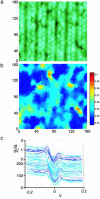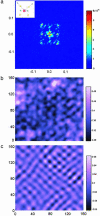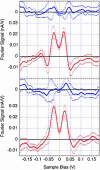Coexistence of periodic modulation of quasiparticle states and superconductivity in Bi2Sr2CaCu2O8+delta
- PMID: 12913127
- PMCID: PMC187829
- DOI: 10.1073/pnas.1233768100
Coexistence of periodic modulation of quasiparticle states and superconductivity in Bi2Sr2CaCu2O8+delta
Abstract
In this article we show, using scanning tunneling spectroscopy, the existence of static striped density of electronic states in nearly optimally doped Bi2Sr2CaCu2O8+delta in zero field. This modulation is aligned with the Cu-O bonds, with a periodicity of four lattice constants, and exhibits features characteristic of a two-dimensional system of line objects. We further show that the density of states modulation manifests itself as a shift of states from above to below the superconducting gap. The fact that a single energy scale (i.e., the gap) appears for both superconductivity and stripes suggests that these two effects have the same origin.
Figures




References
-
- Zaanen, J. & Gunnarsson, O. (1989) Phys. Rev. B Condens. Matter 40, 7391–7394. - PubMed
-
- Emery, V. J. & Kivelson, S. A. (1993) Physica C 209, 597–621.
-
- Kivelson, S. A. & Emery, V. J. (1994) in Strongly Correlated Electronic Materials, Proceedings of the Los Alamos Symposium, 1993, eds. Bedell, K. S., Wang, Z., Meltzer, D. E., Balatsky, A. V. & Abrahams, E. (Addison–Wesley, Reading, MA), p. 619.
-
- Polkovnikov, A., Sachdev, S., Vojta, M. & Demler, E. (2002) Int. J. Mod. Phys. 16, 3156–3163.
LinkOut - more resources
Full Text Sources
Miscellaneous

